
Bees are winged insects closely related to wasps and ants, known for their roles in pollination and, in the case of the best-known bee species, the western honey bee, for producing honey. Bees are a monophyletic lineage within the superfamily Apoidea. They are presently considered a clade, called Anthophila. There are over 16,000 known species of bees in seven recognized biological families. Some species – including honey bees, bumblebees, and stingless bees – live socially in colonies while most species (>90%) – including mason bees, carpenter bees, leafcutter bees, and sweat bees – are solitary.

Beetles are insects that form the order Coleoptera, in the superorder Endopterygota. Their front pair of wings are hardened into wing-cases, elytra, distinguishing them from most other insects. The Coleoptera, with about 400,000 described species, is the largest of all orders, constituting almost 40% of described insects and 25% of all known animal life-forms; new species are discovered frequently, with estimates suggesting that there are between 0.9 and 2.1 million total species. Found in almost every habitat except the sea and the polar regions, they interact with their ecosystems in several ways: beetles often feed on plants and fungi, break down animal and plant debris, and eat other invertebrates. Some species are serious agricultural pests, such as the Colorado potato beetle, while others such as Coccinellidae eat aphids, scale insects, thrips, and other plant-sucking insects that damage crops.

Eucalyptus is a genus of over seven hundred species of flowering trees, shrubs or mallees in the myrtle family, Myrtaceae. Along with several other genera in the tribe Eucalypteae, including Corymbia, they are commonly known as eucalypts. Plants in the genus Eucalyptus have bark that is either smooth, fibrous, hard or stringy, leaves with oil glands, and sepals and petals that are fused to form a "cap" or operculum over the stamens. The fruit is a woody capsule commonly referred to as a "gumnut".
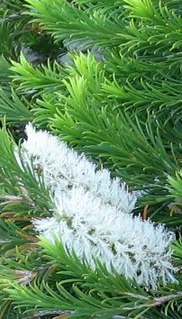
Melaleuca is a genus of nearly 300 species of plants in the myrtle family, Myrtaceae, commonly known as paperbarks, honey-myrtles or tea-trees. They range in size from small shrubs that rarely grow to more than 16 m (52 ft) high, to trees up to 35 m (115 ft). Their flowers generally occur in groups, forming a "head" or "spike" resembling a brush used for cleaning bottles, containing up to 80 individual flowers.

Weevils are beetles belonging to the superfamily Curculionoidea, known for their elongated snouts. They are usually small, less than 6 mm in length, and herbivorous. Approximately 97,000 species of weevils are known. They belong to several families, with most of them in the family Curculionidae. It also includes bark beetles, which while morphologically dissimilar to other weevils in lacking the distinctive snout, is a subfamily of Curculionidae. Some other beetles, although not closely related, bear the name "weevil", such as the biscuit weevil, which belongs to the family Ptinidae.

Passalidae is a family of beetles known variously as "bessbugs", "bess beetles", "betsy beetles" or "horned passalus beetles". Nearly all of the 500-odd species are tropical; species found in North America are notable for their size, ranging from 20–43 mm, for having a single "horn" on the head, and for a form of social behavior unusual among beetles.

Paper wasps are vespid wasps that gather fibers from dead wood and plant stems, which they mix with saliva, and use to construct nests made of gray or brown papery material. Some types of paper wasps are also sometimes called umbrella wasps, due to the distinctive design of their nests.
Ambrosia beetles are beetles of the weevil subfamilies Scolytinae and Platypodinae, which live in nutritional symbiosis with ambrosia fungi. The beetles excavate tunnels in dead, stressed, and healthy trees in which they cultivate fungal gardens, their sole source of nutrition. After landing on a suitable tree, an ambrosia beetle excavates a tunnel in which it releases spores of its fungal symbiont. The fungus penetrates the plant's xylem tissue, extracts nutrients from it, and concentrates the nutrients on and near the surface of the beetle gallery. Ambrosia fungi are typically poor wood degraders, and instead utilize less demanding nutrients. The majority of ambrosia beetles colonize xylem of recently dead trees, but some attack stressed trees that are still alive, and a few species attack healthy trees. Species differ in their preference for different parts of trees, different stages of deterioration, and in the shape of their tunnels ("galleries"). However, the majority of ambrosia beetles are not specialized to any taxonomic group of hosts, unlike most phytophagous organisms including the closely related bark beetles. One species of ambrosia beetle, Austroplatypus incompertus exhibits eusociality, one of the few organisms outside of Hymenoptera and Isoptera to do so.
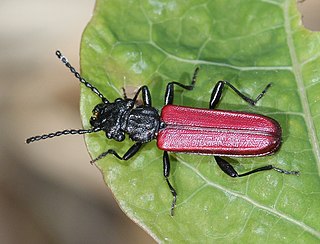
The Cucujidae, "flat bark beetles," are a family of distinctively flat beetles found worldwide under the bark of dead trees. The family has received considerable taxonomic attention in recent years and now consists of 70 species distributed in five genera. It was indicated Cucujus species are scavengers, only feeding on pupae and larvae of other insects and on other subcortical beetles such as their own. Since the Cucujidae prey on larvae of potentially tree damaging beetles that spread fungal diseases, they are considered to be beneficial to the health of living trees.
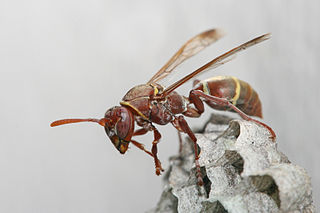
The Polistinae is a subfamily of eusocial wasps belonging to the family Vespidae. They are closely related to the more familiar wasps and true hornets of the subfamily Vespinae, containing four tribes. With about 1,100 species total, it is the second-most diverse subfamily within the Vespidae, and while most species are tropical or subtropical, they include some of the most frequently encountered large wasps in temperate regions.

Haplodiploidy is a sex-determination system in which males develop from unfertilized eggs and are haploid, and females develop from fertilized eggs and are diploid. Haplodiploidy is sometimes called arrhenotoky.

The Boridae are a small family of tenebrionoid beetles with no vernacular common name, though recent authors have coined the name conifer bark beetles. The family contains three genera. Boros is native to North America and northern Eurasia, Lecontia is endemic to North America, while Synercticus is found in Australia and New Guinea. The larvae of Boros are found under bark and are especially associated with standing dead trees (snags), typically pines, found in old-growth forests. Lecontia larvae are found inhabiting damp parts of the root system of dead standing trees. Little is known of the life habits of Synercticus.

Sociality is the degree to which individuals in an animal population tend to associate in social groups (gregariousness) and form cooperative societies.
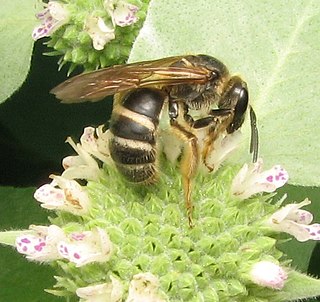
The sweat bee genus Lasioglossum is the largest of all bee genera, containing over 1700 species in numerous subgenera worldwide. They are highly variable in size, coloration, and sculpture; among the more unusual variants, some are cleptoparasites, some are nocturnal, and some are oligolectic. Most Lasioglossum species nest in the ground, but some nest in rotten logs.
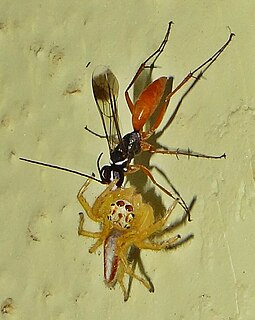
Mass provisioning is a form of parental investment in which an adult insect, most commonly a hymenopteran such as a bee or wasp, stocks all the food for each of her offspring in a small chamber before she lays the egg. This behavior is common in both solitary and eusocial bees, though essentially absent in eusocial wasps.

Eusociality, the highest level of organization of sociality, is defined by the following characteristics: cooperative brood care, overlapping generations within a colony of adults, and a division of labor into reproductive and non-reproductive groups. The division of labor creates specialized behavioral groups within an animal society which are sometimes referred to as 'castes'. Eusociality is distinguished from all other social systems because individuals of at least one caste usually lose the ability to perform at least one behavior characteristic of individuals in another caste. Eusocial colonies can be viewed as superorganisms.

Austroplatypus incompertus is a species of ambrosia beetle belonging to the true weevil family, native to Australia, with a verified distribution in New South Wales and Victoria. It forms colonies in the heartwood of Eucalyptus trees and is the first beetle to be recognized as a eusocial insect. Austroplatypus incompertus is considered eusocial because groups contain a single fertilized female that is protected and taken care of by a small number of unfertilized females that also do much of the work. The species likely passed on cultivated fungi to other weevils.

Eusociality evolved repeatedly in different orders of animals, particularly the Hymenoptera. This 'true sociality' in animals, in which sterile individuals work to further the reproductive success of others, is found in termites, ambrosia beetles, gall-dwelling aphids, thrips, marine sponge-dwelling shrimp, naked mole-rats, and the insect order Hymenoptera. The fact that eusociality has evolved so often in the Hymenoptera, but remains rare throughout the rest of the animal kingdom, has made its evolution a topic of debate among evolutionary biologists. Eusocial organisms at first appear to behave in stark contrast with simple interpretations of Darwinian evolution: passing on one's genes to the next generation, or fitness, is a central idea in evolutionary biology.
Synalpheus regalis is a species of snapping shrimp that commonly live in sponges in the coral reefs along the tropical West Atlantic. They form a prominent component of the diverse marine cryptofauna of the region. For the span of their entire lives, they live in the internal canals of the host sponge, using it as a food resource and shelter. It has been shown that colonies contain over 300 individuals, but only one reproductive female. Also, larger colony members, most of which apparently never breed, defend the colony against heterospecific intruders. This evidence points towards the first known case of eusociality in a marine animal.
Kladothrips is a genus of Australian gall thrips. It is notable for including some of the few organisms outside of Hymenoptera that exhibit eusociality.

















